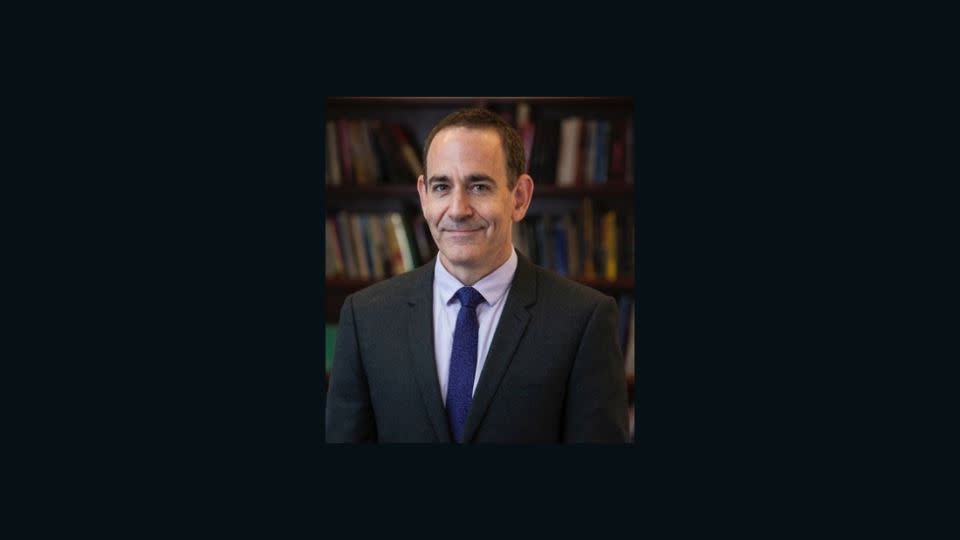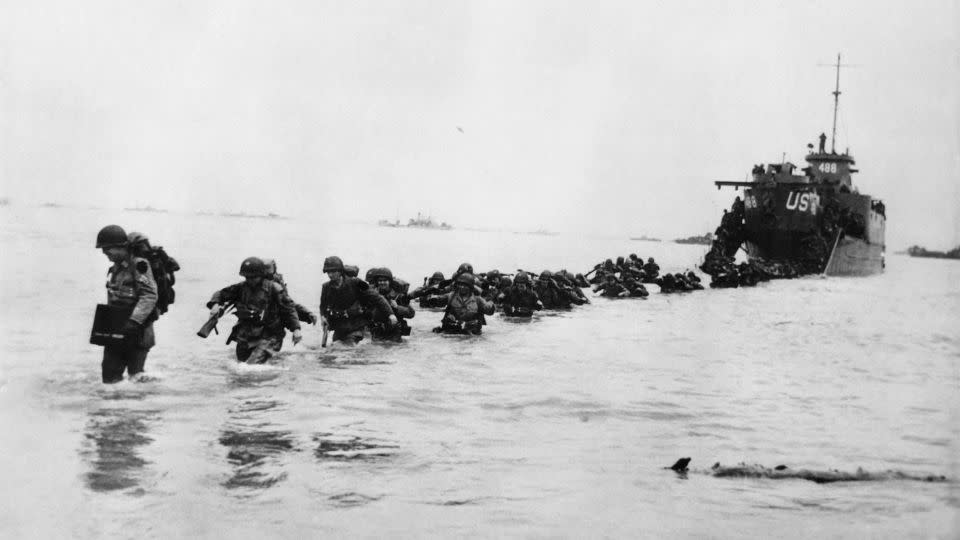Opinion: The man who fooled Hitler
Editor’s Note: Tim Naftali is a CNN presidential historian and senior research scholar at Columbia University’s School of International and Public Affairs. The views expressed here are his own. Read more opinion on CNN. The CNN Original Series “Secrets & Spies: A Nuclear Game” airs on Sundays at 10 p.m. ET/PT.
As we remember and celebrate the heroism of the Allied troops on D-Day 80 years ago, it is worth mentioning that even more of them would likely have died had it not been for a group of spies working on behalf of the Allies.

The odds of D-Day succeeding were never overwhelming. Approximately 50,000 Nazi soldiers defended the five beaches targeted by Allied troops on D-Day. Although eventually 160,000 Allied troops would enter France through those five beachheads that day, the very first to reach the shore were vastly outnumbered and outgunned. But getting past those first Nazi defenders, protected by bunkers and other fortifications of the so-called Atlantic Wall, was only the first challenge.
The second was what would happen once the Germans figured out that the Battle for France had begun. Hitler’s 15th Army was stationed in the Pas des Calais — where the English Channel is at its most narrow — while tank divisions were kept in reserve in northern France and Belgium, all ready to swoop in and destroy any Allied forces that breached the Atlantic Wall. To increase their chance of success, Allied leaders turned to inhabitants of the secret world.
These were unusual spies. First of all, their main job was to get false information to Adolf Hitler — rather than to steal Nazi secrets. And, secondly, some of these spies didn’t actually exist — they were completely made-up creations of British intelligence. A half-century before the internet was widely available, they were the forerunners of fake Facebook and Instagram accounts.
These spies were known to British and US intelligence as the Double-Cross network. They were agents employed by the Nazis, who either turned themselves in to the British or were captured by them in the first years of World War II.
Counterespionage is the most arcane of the dark arts. In its simplest form, it is the way a government protects its secrets by studying the activities of foreign governments who want them. But World War II would see a dramatic expansion of the offensive use of counterspies — not simply to prevent the enemy from knowing things but to actively deceive the enemy by planting disinformation. And although strategic deception, as it was called, would be used a number of times in World War II, the most dramatic and consequential example was part of the planning for D-Day.
The British used members of the Double-Cross network who were doubled back against Berlin to deceive Hitler’s military intelligence service, using radio transmissions from the UK or letters sent from neutral capitals about when and where the Allies planned to launch their anticipated invasion of occupied France.
Central to this deception operation was Juan Pujol García, a Spanish national who was codenamed Garbo, after the great actress Greta Garbo. As it became clear that the Germans not only believed Garbo, but considered him unusually effective, the British began to create fictional sub-agents for him. With the help of his British handler, Garbo would feed disinformation about these completely made-up agents who were supposedly placed in the British government and US bases in the United Kingdom. The British coordinated with the US military and its Office of Strategic Services (OSS) and they bolstered the disinformation Garbo was feeding to Berlin. This included transmitting radio signals from non-existent US military units in Britain and creating “ghost armies” — complete with inflatable tanks, fake radio traffic and sound effects — to deceive German air reconnaissance and divert their attention away from the activities of real units.

Starting in January 1944, Garbo and his “agents” began to build a fake picture in German minds of a D-Day that would occur in July 1944 in the Pas de Calais. According to the fake intelligence created and spread by the Double-Cross network, the big invasion would be preceded by one or more feints — smaller invasions designed to distract the Germans. To make this two-punch scenario plausible, Allied deception officers worked to make the Germans think that there was a massive buildup of Allied troops in the UK preparing to pounce on the Third Reich, including a completely fake “ghost army” commanded by the real General George Patton from across the Pas de Calais.
A key objective of this deception was to convince Hitler to keep the 15th Army and tank divisions in reserve, away from the Normandy beaches for as long as possible, so as to give Allied soldiers a fighting chance to secure a beachhead. Led by Garbo, the Double-Cross network sang in chorus.
As the real D-Day approached, the Allies could tell that the deception was working. Hitler was uncharacteristically talkative with the Japanese ambassador to Berlin, whose encrypted dispatches to Tokyo were routinely broken and translated by US intelligence. Hitler told the Japanese that the allies intended two attacks across the English Channel in the summer of 1944 and he wasn’t about the be fooled by the first one.
Remarkably, as hoped, the deception held. The Nazis did not divert all of their resources to Normandy, since their military intelligence continued to believe that the big one was still imminent. As late as July 8, 1944, a month after D-Day, Hitler still believed that Normandy was a feint. As such, he refused requests from his generals to throw everything at it. “The enemy has succeeded in landing in Normandy,” Hitler wrote to his commanders. “In spite of the attendant risks, the enemy will probably attempt a second landing in the 15th Army’s sector…”

Decades ago, as I was researching what ultimately became my dissertation, I had the good fortune to meet some of the surviving British MI-5 officers who were in charge of these Double-Cross agents. These were inventive, disciplined intelligence officers whose talent was not only managing the agents captured in England, but also brilliantly imitating the way they reported to their Nazi case officers and figuring out how to weave reality and falsehood into messages that would be plausible to the ultimate intelligence consumer in Berlin.
I also met the man who came up with the D-Day deception, Roger Fleetwood Hesketh, who was a trained architect. He told me that for the D-Day deception, codenamed Fortitude South, he had drawn on different talents. He had grown up with one sibling on a big estate (where he still lived when I visited him in the 1980s) near Liverpool. He and his sister compensated for not having many friends their own age nearby by creating a fantasy world of playmates. A sandbox conspiracy, if you will, that seemed very real to them but, of course, only existed in their own minds.
Besides being creative, one of the keys to the brilliant counterespionage campaigns in World War II was the codebreaking that allowed the Allies to assess whether their efforts were working, and double down once it became clear the Nazis were taking the bait. Not only could the US read what the Japanese were saying about how Hitler viewed the progress of the war in Europe, but US and British codebreakers could also read what German intelligence officers were saying amongst themselves about the trustworthiness of its agents in the UK — part of Ultra, the UK-led intelligence project against all high-level Nazi military communications. Codebreakers at the British facility Bletchley Park, chief among whom was the computing and LGBTQ pioneer Alan Turing, routinely broke the codes and ciphers that the Germans unsuccessfully used to disguise their most important messages. From Ultra, allied counterspies learned that German intelligence trusted double agents’ disinformation campaign about the invasion of France.
While much of the counterespionage during WWII remained a secret to the public for nearly 30 years after June 6, 1944, these tactics were well known among intelligence officers and widely used during the Cold War. The Soviets learned about the Double-Cross network from two well-placed spies of their own — moles Anthony Blunt in MI5 and Kim Philby in MI6’s counterespionage service, Section V or XB.
The D-Day achievement would set a very high-bar for those who learned the craft of counterespionage in fighting Hitler. What they couldn’t possibly have known in 1944 was that they were living through a golden age in counterespionage and strategic deception. As depicted dramatically in CNN’s new original series “Secrets & Spies: A Nuclear Game,” the Cold War would provide a more evenly matched, and, therefore, more difficult environment for the spy v. spy game.
Evaluating human intelligence is always messy and challenging. If you are a case officer — the manager of a particular agent — it can be incredibly difficult to know whether he or she is telling the truth. In other words, when dealing with double agents, being certain about their ultimate loyalty is a virtual impossibility.
With one major exception, neither the Western powers nor the Soviets had a reliable window into what their adversaries’ spies were up to for most of the decades-long conflict between the US and USSR.
Finding traitors during the Cold War got harder, and intelligence services became more susceptible to futile “mole” hunts and the paranoia that those naturally inspired. It also permitted the moles that did exist to secretly influence how the adversaries understood each other. Sometimes, as in the case of Oleg Gordievsky, a KGB officer working for the British, it worked to the benefit of world peace and stability as Gordievsky gave timely warning to London and Washington of the Kremlin’s nuclear paranoia.
Sometimes, however, the insufficiency of counterespionage made the world a more dangerous place. For 20 years, starting in 1979, the top US counterespionage officer working on the Soviet target in America, the FBI’s Robert Hanssen, was himself a Soviet agent. As was the CIA’s counterintelligence officer who managed security for its agents in the Soviet Union, Aldrich Ames.
The crisis in US counterespionage against the USSR in the 1980s — largely due to the simultaneous activities of Hanssen and Ames — hampered efforts in the West to monitor and understand fully the Soviet Union as it underwent a massive period of reform and, ultimately, collapse. Fortunately, Mikhail Gorbachev, who came to power in 1985, did much of his most significant work overtly — trying to signal that he was a different kind of leader to the West as much as to his own people.
Now, 80 years after D-Day and 35 years after the end of the Cold War, fake identities and disinformation are no longer relegated to the concerns of counterespionage agents. They are part of our daily online feeds. In a sense, each of us has become our own counter-deception officer, trying to distinguish misinformation from what’s real. A strategy once perfected to save lives and defeat arguably the worst dictator the world has ever known has become commonplace online — and eroded our trust in institutions and each other.
For more CNN news and newsletters create an account at CNN.com


